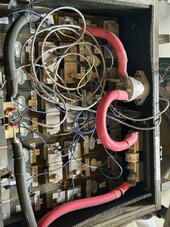Sloppy and frugal reminds me of my mother's second husband. They put a cheap 3ft tall 10ft round above ground pool on the back porch. He got it free from someplace. The heater/filter unit for it would have cost a hundred bucks.
So they had a few methods for heating it.
First was a garden hose thrown into the hot tub and attached to a circulation pump, just a closed loop heat transfer system. And it worked for a few months until the heater on the hot tub burned up from over use.
Next he took the hose and attached it to a coil of copper tubing and set that down into a metal 30 gallon trashcan. When the pool got a little chilly he would just build a fire in the trashcan and let the pump circulate water still in a closed loop. Problem with this is the hot water didn't loose enough heat on the loops and the little pump wasn't built for high temps and it died after a month.
So, what is a man to do? Well, he took the electric heating element out of an old junk waterheater that he intended to cut in half to make a smoker out of. Cut the ends off an extension cord. Wrap the naked wires around the back end of the element. Then he drilled a hole in a 2x4 an pushed the element through. Now toss that in the water face down and it did a fair job of heating the top 18 inches of the water. The board kept the element from sinking and the water kept the board from catching fire. Just have to remember to unplug before using the pool.
And they used it like that for 6 months until winter came along and the pool split its side because the little heater couldn't keep up.




